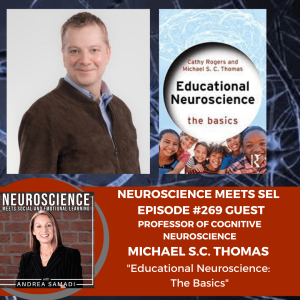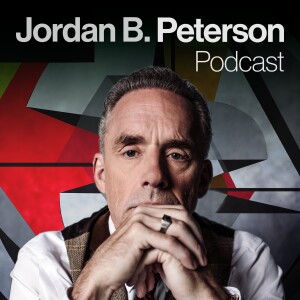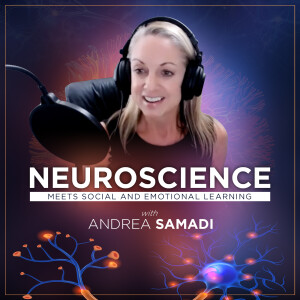
WHAT IS THE POTENTIAL OF EDUCATIONAL NEUROSCIENCE?
British Physician, Ben Goldacre, 2013 says “I think there is a huge prize waiting to be claimed by teachers. By collecting better evidence about what works best and establishing a culture where this evidence is used as a matter of routine, we can improve outcomes for children, and increase professional independence.”
Watch this interview on YouTube here https://youtu.be/Uh1BZOTGZQc
On today’s Episode #269 we will cover
✔ Professor Michael S.C. Thomas' new book Educational Neuroscience: The Basics
✔ Where is educational neuroscience NOW? Where it began, and where it's going.
✔ How this book can help students improve how they learn.
✔ How this look at Educational Neuroscience can help us to become better teachers.
✔ The difference between evidence-based and neuroscience-based.
✔ Where we should ALL begin. What IS the BASICS of Neuroscience?
✔ What makes something forgettable and another thing memorable?
✔ Ways to make learning easier.
Welcome back to The Neuroscience Meets Social and Emotional Learning Podcast where we bridge the gap between theory and practice, with strategies, tools and ideas we can all use immediately, applied to the most current brain research to heighten productivity in our schools, sports environments and modern workplaces. I’m Andrea Samadi and launched this podcast almost 4 years ago, to share how important an understanding of our brain is for our everyday life and results. This season (Season 9) we will be focused on Neuroscience: Going Back to the Basics for the next few months, as we welcome some phenomenal pioneers in the field of Neuroscience, paving a pathway for all of us to navigate our lives with more understanding with our brain in mind. My goal with this next season (that will run until the end of June) is that going back to the basics will help us to strengthen our understanding of the brain, and our mind, to our results, and provide us with a springboard to propel us forward in 2023, with this solid backbone of science.
Today’s guest and EPISODE #269, I’ve been wanting to have on this podcast since I came across his work in the field of educational neuroscience around the time we interviewed Dr. Daniel Ansari, back in June 2021 for EPISODE #138.[i] I saw their Annual Research Review: (called) Educational Neuroscience progress from April 2019, written by Michael S.C. Thomas, Daniel Ansari and Victoria C.P. Rowland that provided a thorough overview of the origins of educational neuroscience, outlining where it began, the challenges it faces as a “translational field” and addressed it’s major criticisms. I immediately wrote down Michael S.C. Thomas’ name, along with his email address, to reach out to him to learn more of his perspective in this field. Since I was interviewing Dr. Daniel Ansari, it brought something to light for me that the people who write these research reports that we find on Pubmed.gov, are working hard somewhere, and not completely out of reach if you really want to find them, and ask them some questions about their work. When I finally emailed him, I was thrilled to hear he had a NEW book Educational Neuroscience: The Basics[ii] and am grateful to have this opportunity to speak with him about this new book.
Before we meet our next guest, Michael S.C. Thomas, let me orient you to his work.
Michael S. C. Thomas is a Professor of Cognitive Neuroscience at Birkbeck University of London. Since 2010, he has been Director of the Centre for Educational Neuroscience, a cross-institutional research centre which aims to further translational research between neuroscience and education, and establish new transdisciplinary accounts in the learning sciences. In 2003, Michael established the Developmental Neurocognition Laboratory within Birkbeck’s world-leading Centre for Brain and Cognitive Development. The focus of his laboratory is to use multi-disciplinary methods to understand the brain, including behavioural, brain imaging, computational, and genetic methods. In 2006, the lab was the co-recipient of the Queen’s Anniversary Prize for Higher Education, for the project “Neuropsychological work with the very young: understanding brain function and cognitive development”. Michael is a Chartered Psychologist, Fellow of the British Psychological Society, Fellow of the Association for Psychological Science, Senior Fellow of the Higher Education Academy, and board member of the International Mind Brain and Education Society.
Let’s meet Professor of Cognitive Neuroscience, Michael S. C. Thomas, from Birkbeck University of London and see what we can learn about Educational Neuroscience: The Basics.
Welcome Michael, thank you for sticking with me as we made this interview happen. I’ve been wanting to speak with you for so many years that I was trying to change Wednesday yesterday to Thursday to speed up time because I know how important this new book is, and am so very grateful for this chance to learn more about this topic directly from you. Thank you for being here today.
INTRO: How did you find your way towards studying the brain as it relates to our educational system and establish the Developmental Neurocognition Laboratory within Birkbeck’s Centre for Brain and Cognitive Development?
If I look at Unlocke.org[iii] is this where your research is based?
Moving towards your NEW book, Educational Neuroscience: The Basics that is the reason we are here today, what can you tell us about writing this new book with Cathy Rogers, who moved to this field of neuroscience after years of producing science television shows. I can only imagine how her background in television and film contributed to this book.
Q1: When I first came across your work, it was when I was interviewing Dr. Daniel Ansari, and I found the Annual Research Review[iv] you wrote with him and Victoria Knowland. I don’t often sit and read through Pubmed in my spare time, but I was working on a paper for a Neuroscience Certification that required me to know how to navigate through the research, and after reading your report, this was the first time I was ever aware of criticisms in this field (this was before I learned about the Reading Wars[v]). Then I read Dr. Ansari’s review Bridges over troubled waters[vi] and I wonder if you could bring our listeners up to speed of where this field began, where it is now (you say “it’s barely out of the gates” and where do you see it going?
Q2: This brings us back to your new book with Cathy Rogers, Educational Neuroscience: The Basics that is an introduction to this interdisciplinary field. British physician Ben Goldacre said that there’s “a huge prize waiting to be claimed by teachers” with this book.
What are your goals with this book, Educational Neuroscience: The Basics, and how do you see it improving outcomes for students, like Ben Goldacre mentioned, while “increasing professional independence” for our next generation of teachers?
Q3: I’ve seen some graphics made over the years that show how Neuroeducation consists of the Pedagogy of Education and Learning, Neuroscience, with the brain and its functioning, and Psychology, combining the mind and behavior. (The 3 circles interconnecting) with Neuroeducation in the middle. With your research between neuroscience and education, and your background in psychology, how would you draw this diagram? What disciplines would you say make up Educational Neuroscience?
Q3B: I loved seeing a book that really does go back to the basics. This is fundamental for all of us, whether we work in the classroom with our students, in sports environments, or in the corporate workplace. I saw some of your testimonials at the start of the book say that “this book is essential reading for anyone who wants to learn how the brain works to enable learning” and after reading Chapter 1, I wonder “why do we need educational neuroscience, how can it help us to understand how we learn, and help us to become better teachers?
Andrea thinks that Michael has answered this question, with the idea that we want our students to use movement, manage their emotions, and social interactions, so these don’t get in the way of learning, thinking and cognition.
Q4: Can we go next to the research. This question would benefit those who create programs for schools, or for those who are selling programs to schools, or even for those who work in schools to understand this difference. I’ve spent countless hours (from a program creator point of view) trying to figure this out for certain funding buckets. What is the distinction between “evidence-based” and “neuroscience-based and does one provide a more guaranteed outcome for student success?”
Q5: When I read of the survey you mentioned of the teachers of Wellcome Trust (Simmonds, 2014) that found a high level of interest in neuroscience and 60% of teachers said they “knew little” about how the brain works, and
82% said they wanted to learn more, it reminded me of why we launched this podcast to help bring together all the leaders in the field like you said to address this “unmet appetite for neuroscience knowledge.” But then when asked about their current use it was noted there were many tools, and products that claimed to boost a student’s brain level, without the evidence. I know that CASEL has a program rating system for social and emotional learning programs, but what do you is there a rating systems for neuroscience or evidence- based programs?
Q6: I love that you quoted David A. Sousa (Hart, 1999, Sousa, 2011) in Chapter 1 with his quote that “teachers are the only people whose specific job is to change the connections between neurons in their students’ brains.” He’s been on our podcast twice, most recently EP197[vii] with his 6th edition of How the Brain Learns was our third most listened to episode of 2022. I’ve got to say that when I was first handed his books back in 2014, and asked to add neuroscience to the character and leadership programs I had created for the school market, I took one look at the images of the brain, or even how our memory works, and I felt overwhelmed, and almost didn’t go in this direction. What would you say to someone who looks at the word neuroscience, and feels the same level of intimidation that I felt in the beginning. Where should someone begin? What are the BASICS of Neuroscience?
- Plasticity
- Learning and Altering Neuron Connections
- Memories/Forgetting
Q7: What makes something unforgettable while other things we struggle to remember?
Q8: To sum this all up, In chapter 5, Thinking is Hard, and different types of memories perform different types of functions, or working with memory for specific things or events. Then you cover “We feel, therefore we learn.” (Immordino-Yang & Damasio). What should we all take away to help us to all understand Neuroscience: The Basics and make learning easier?
If thinking is hard, why is learning harder? What makes learning easier?
Michael, I want to thank you very much for taking the time to come on the podcast (all the way from the UK) and for sharing your new book Neuroscience: The Basics with us. For people who want to purchase the book, is the best place https://www.routledge.com/Educational-Neuroscience-The-Basics/Rogers-Thomas/p/book/9781032028552#
CONTACT MICHAEL S.C. THOMAS
Email m.thomas@bbk.ac.uk
Research Unlocke.org
BUY Educational Neuroscience: The Basics
Educational Neuroscience: The Basics by Cathy Rogers and Michael S.C. Thomas Published November 15, 2022 https://www.routledge.com/Educational-Neuroscience-The-Basics/Rogers-Thomas/p/book/9781032028552#
Amazon https://www.amazon.com/Educational-Neuroscience-Basics-Cathy-Rogers/dp/1032028556
Professor Michael Thomas at Birkbeck University of London https://www.bbk.ac.uk/our-staff/profile/8006159/michael-thomas#overview
Center for Educational Neuroscience http://www.educationalneuroscience.org.uk/
YouTube https://www.youtube.com/channel/UCMlW1aThiDY5TB8uxS3DU0w
Stay tuned for Michael’s NEXT book How the Brian Works.
FOLLOW ANDREA SAMADI:
YouTube Channel: https://www.youtube.com/c/AndreaSamadi
Website https://www.achieveit360.com/
LinkedIn: https://www.linkedin.com/in/samadi/
Facebook: https://www.facebook.com/Achieveit360com
Neuroscience Meets SEL Facebook Group https://www.facebook.com/groups/2975814899101697
Twitter: https://twitter.com/andreasamadi
Instagram: https://www.instagram.com/andreasamadi/
Thank you!
REFERENCES:
[i] https://andreasamadi.podbean.com/e/professor-and-canada-research-chair-in-developmental-cognitive-neuroscience-and-learning-on-the-future-of-educational-neuroscience/
[ii] Educational Neuroscience: The Basics by Cathy Rogers and Michael S.C. Thomas Published November 15, 2022 https://www.routledge.com/Educational-Neuroscience-The-Basics/Rogers-Thomas/p/book/9781032028552#
[iii] https://www.unlocke.org/team.php
[iv] Annual Research Review: Educational neuroscience: progress and prospects by Michael S.C. Thomas, Daniel Ansari and Victoria C.P. Knowland (April 2019) https://www.ncbi.nlm.nih.gov/pmc/articles/PMC6487963/
[v] The Reading Wars by Nicholas Lemann https://www.theatlantic.com/magazine/archive/1997/11/the-reading-wars/376990/
[vi] Bridges over troubled waters: education and cognitive neuroscience by Daniel Ansari, Donna Coch March 10, 2006 https://pubmed.ncbi.nlm.nih.gov/16530462/
[vii] Neuroscience Meets Social and Emotional Learning Podcast EPISODE #197 with David A Sousa on “What’s NEW with the 6th Edition of How Your Brain Learns” https://andreasamadi.podbean.com/e/returning-guest-dr-david-a-sousa-on-what-s-new-with-the-6th-edition-of-how-the-brain-learns/
More Episodes
Brain Fact Friday ”Chronic Pain and the Brain: Is it All in Your Head?”
 2022-07-14
2022-07-14
 1.5k
1.5k
Howard Rankin, Ph.D on ”Falling to Grace: The Art and Science of Redemption”
 2022-07-12
2022-07-12
 1.5k
1.5k
Brain Fact Friday ”Review of Heart Rate Variability: The Most Important Biomarker for Tracking Health, Recovery and Resilience.”
 2022-07-07
2022-07-07
 1.4k
1.4k
CASE STUDY: Manjula Veeranna from India on ”Transforming Lives with a Brain-Based Classroom”
 2022-06-30
2022-06-30
 1.5k
1.5k
Brain Fact Friday ”Using Neuroscience to Explain Why Our Dreams Are So Weird, Highly Emotional, and Often Forgotten”
 2022-06-23
2022-06-23
 1.5k
1.5k
CASE STUDY: Ellie Mercado, Assistant Principal from Ossining, NY on ”Embedding Social and Emotional Learning with an Equity Lens”
 2022-06-22
2022-06-22
 1.6k
1.6k
Harvard Neuroscientist Dr. Baland Jalal Explains ”Sleep Paralysis, Lucid Dreaming and Premonitions: Expanding our Awareness into the Mysteries of Our Brain During Sleep”
 2022-06-20
2022-06-20
 1.7k
1.7k
Reducing the Risk of Alzheimer’s Disease by Understanding Sleep and the Brain
 2022-06-16
2022-06-16
 1.4k
1.4k
Jason Littlefield and Erec Smith from EmpowerED Humanity on ”A Framework for SEL Through the Lens of Human Dignity and Neuroscience”
 2022-06-14
2022-06-14
 1.4k
1.4k
Dr. John Denboer on ”This is Dementia: Disrupting the Decline”
 2022-06-13
2022-06-13
 1.5k
1.5k
Rich Carr and Dr. Kieran O’Mahony from Brain-centric Design on ”The Surprising Neuroscience Behind Learning With Deep Understanding”
 2022-06-09
2022-06-09
 1.6k
1.6k
Secret Millionaire, Hilary Decesare on her new book coming June 9th ”ReLaunch: Spark Your Heart to Ignite Your Life.”
 2022-06-02
2022-06-02
 1.5k
1.5k
Brain Fact Friday on ”Using Neuroscience and Dr. Covey’s 5th Habit to Find Peace and Hope During Difficult Times”
 2022-05-26
2022-05-26
 1.6k
1.6k
Brain Fact Friday on ”Science-Based Tricks to Improve Productivity and Never Forget Anything”
 2022-05-20
2022-05-20
 1.6k
1.6k
Assistant Principal Dan Wolfe on ”Becoming the Change: Using the 5 SEL Competencies to Navigate Through Difficult Times”
 2022-05-18
2022-05-18
 1.6k
1.6k
Chey Cheney and Pav Wander from The Chey and Pav Show on ”Their Vision to Identify and Amplify the Voices Often Left Behind.”
 2022-05-16
2022-05-16
 1.5k
1.5k
Marie Gervais, Ph.D on ”The Spirit of Work: Connecting Science, Business Practices and Our Spirit for a Happier and More Productive Workplace.”
 2022-05-11
2022-05-11
 1.5k
1.5k
Brain Fact Friday ”Using Neuroscience to Improve Our Work Lives”
 2022-05-06
2022-05-06
 1.5k
1.5k
The Burnout Doc, Sharon Grossman, PhD on ”A Research-Based Approach to Preventing Work Burnout From the Inside Out.”
 2022-05-04
2022-05-04
 1.7k
1.7k
Brain Fact Friday on ”The Neuroscience of Dreams: Expanding Our Self-Awareness”
 2022-04-28
2022-04-28
 1.6k
1.6k
Get your brand heard on this podcast
Join Podbean Ads Marketplace and connect with engaged listeners.
Advertise Today
Create your
podcast in
minutes
- Full-featured podcast site
- Unlimited storage and bandwidth
- Comprehensive podcast stats
- Distribute to Apple Podcasts, Spotify, and more
- Make money with your podcast
It is Free
You may also like

Mayo Clinic Talks


The Saad Truth with Dr. Saad


Positive Thinking Mind


ŒIL pour YEUX, DENT pour MÂCHOIRE 😎


The Jordan B. Peterson Podcast


- Privacy Policy
- Cookie Policy
- Terms of Use
- Consent Preferences
- Copyright © 2015-2024 Podbean.com



 iOS
iOS Android
Android